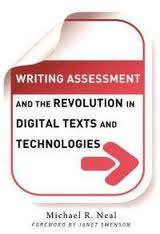Review Conversation
In Part Two Neal shifts his focus from evaluating writing assessments as technologies to describing writing assessments that employ technology. A key component of this rhetorical shift is Neal's assumption that educators and administrators are increasingly integrating digital methods and instruments into the act of writing assessment. Beginning in Chapter Four, we are introduced (or for some of us re-acquainted with) an explicated review of technologically integrated writing assessment literature in our field.
Neal channels Mem Fox's text "Notes from the Battlefield: Toward a Theory of Why People Write" (1988), when he succinctly lists four specific challenges to how technology informs assessment of student writing: labor (who will do it); criteria (what content is assessed); fairness (how to measure consistency among different learning levels of students); and cost effectiveness (how much will it cost and who is paying for it). Neal's argument for the last item is well noted. He posits that the answer to cost can tell us about "how writing – its teaching and assessment – is understood and valued by an institution" (p. 62).
Neal synthesizes other scholars' experiences with several assessment technologies, most notably machine-scored instruments. He includes Anne Herrington and Charles Moran's article, "What Happens When Machines Read our Students' Writing?," Bob Condon's evaluations of the implications when machines score student writing, and Bob Broad's prediction of technology as a site for future battles in writing assessment. Neal further details Tim McGee's experiences with Pearson's Intelligent Essay Assessor (IEA) and Edmund Jones' experiments with ACCUPLACER essay-scoring software. Neal concludes his review and the chapter itself with an evaluation of discussions in our field surrounding machine-scored assessments. He argues that in this discussion we have lost sight of an important idea – "why and how people read and write within meaningful rhetorical situations" (p. 74). Neal sets the reader up to follow him through his outline and examples of how we can employ technologies without allowing them to dehumanize and mechanize the social acts and exigencies of writing.
